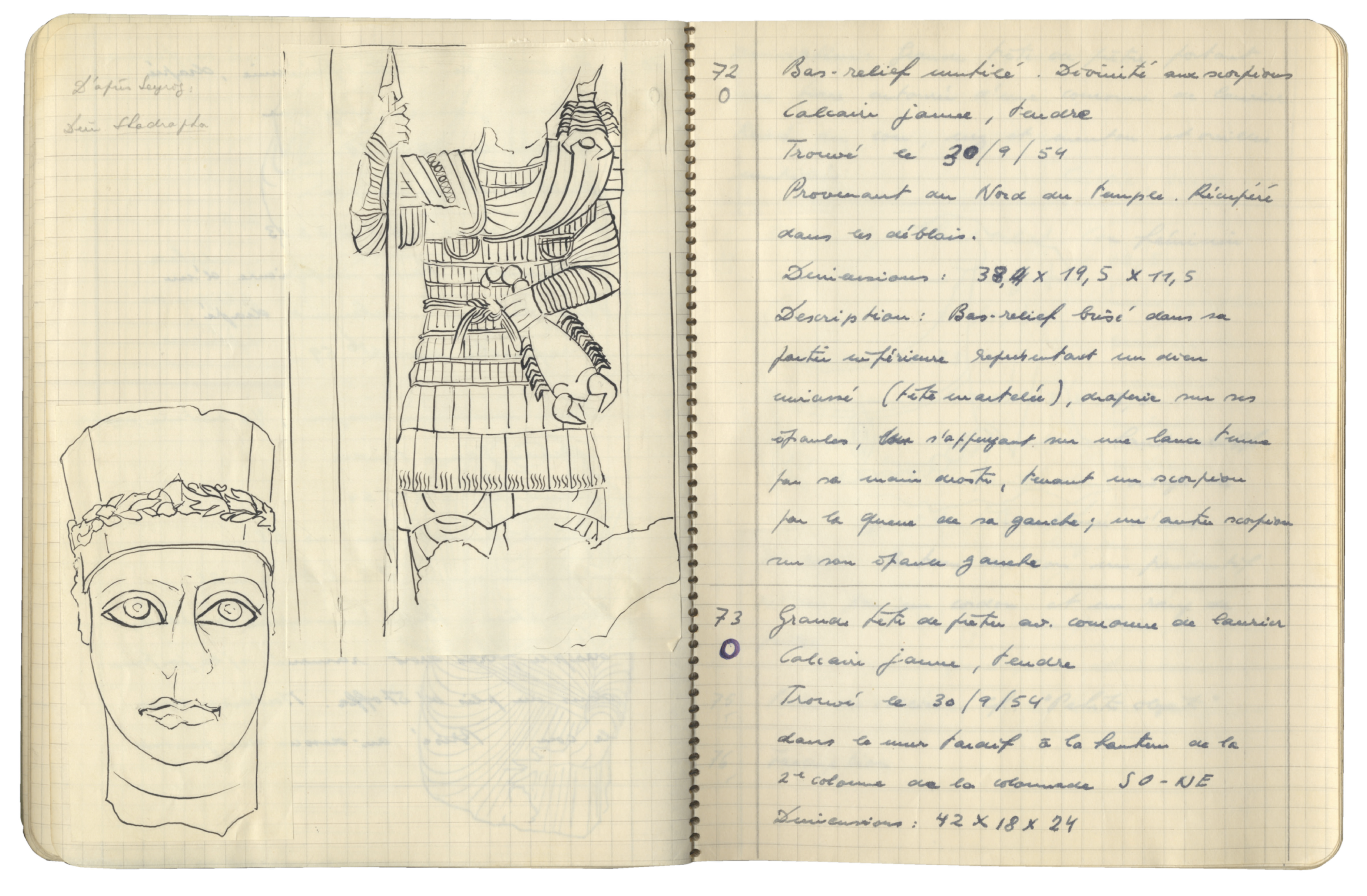Content :
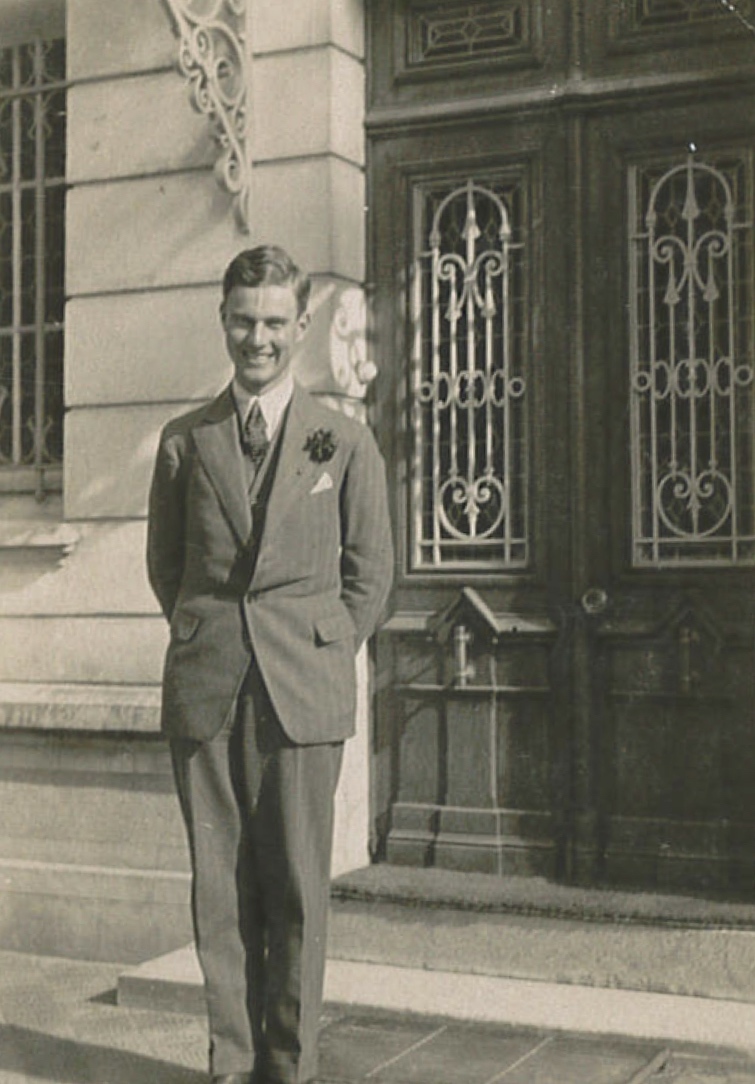
Summary :
The Collart-Palmyre project was created in 2017 by the Institute of Archeology and Classical Studies of the University of Lausanne following the significant damage made to the Syrian architectural heritage, especially in and Palmyra in 2015. The photographic archive associated with the Swiss archeo-logist Paul Collart, who, between 1954 and 1956, lead a major excavation campaign centred around the Baalshamîn temple, is held by the University of Lausanne. It represents a unique source to study the monument, which has been completely destroyed.
Aims
The Collart-Palmyre Project includes four axes linked to the now-destroyed Baalshamîn Temple in Palmyra (Syria):
- 1. Creating databases and 3D models of the temple based on Paul Collart’s archives (in partnership with Iconem Paris, Scott Mcavoy UC San Diego, EPFL Pavilions’ team in Lausanne, Digital Library of the Middle East and Aga Khan Trust for Culture among others);
- 2. Delivering socio-pedagogical activities linked to Syrian tangible and intangible heritage worldwide (including embroidery workshops in Syria and Jordan with UNDP Syria, with the NGO The Day After and InZone (Geneva University);
- 3. Developing a tool (an Object ID Database) to help fighting against illicit trafficking of cultural goods form Syria in partnership with ICOM-Austria and its stakeholders;
- 4. Disseminating the project through exhibitions (in Paris, Bonn, Lausanne, Washington, and Expo Dubaï 2020), lectures, international conferences (in Europe and in the USA), social media activities, published works in Arabic.
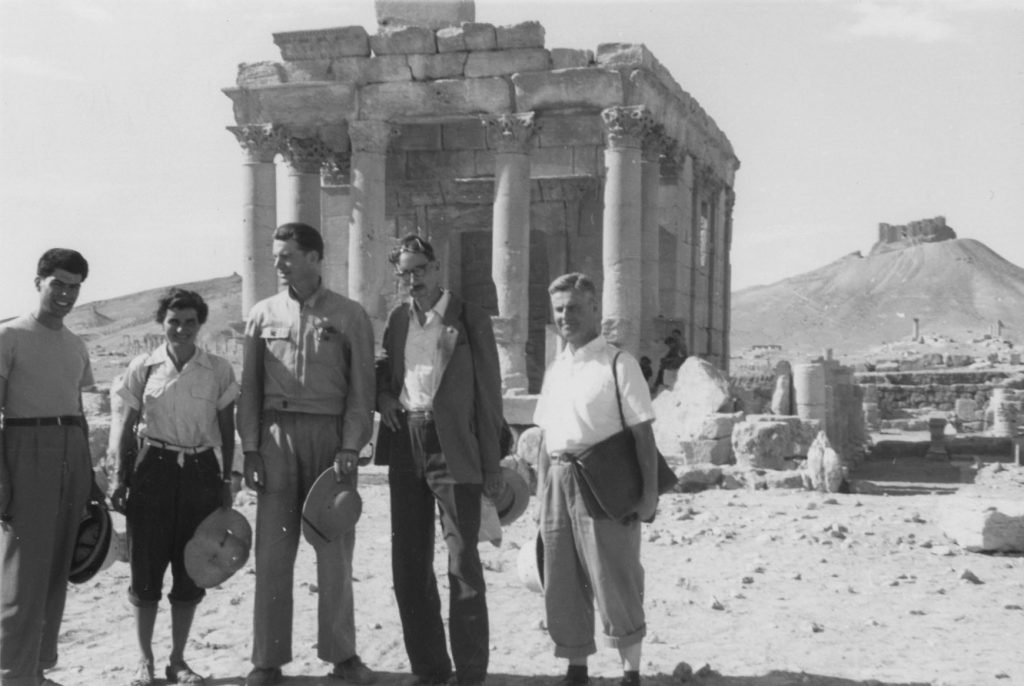
Collaborations :
The above activities are meant to preserve Syrian cultural heritage at risk and foster resilience. Thanks to a series of workhops created with UNDP-Syria in the “Dealing with the Past” program, access has been granted to the documents and scientific data produced within the framework of the Collart-Palmyre project.
The documents produced are based on the scientific work conducted by the Swiss archaeologist Collart. In Azraq Camp, InZone’s learning centre has been equipped with 3D goggles (Oculus Quest) and tablets to allow Syrian residents to experience 3D technology and virtual reality.
Following the involvement of the University of Lausanne researchers in an important exhibition in Paris at the “Institut du monde arabe” in the fall of 2018, then in 2019 at the Bundeskunsthalle in Bonn (Germany) and at the Smithonian in Washington DC, later with EPFL in Lausanne (Deep fakes: Art and its Double), as well as the presentation of the project at the Academia dei Lincei in Rome at the invitation of the Balzan Foundation, the project has been granted wide visibility within the European cultural and academic landscape. An International Conference was organised by the Project in Lausanne in December 2019, followed by a meeting at UNESCO’s headquarters in Paris, where recommendations made by UNIL were noted by UNESCO.
The Project was also selected to represent Swiss Innovation in the “Tolerance and Inclusivity Week” at the Swiss Pavilion at Expo Dubai 2020 in November 2021. The Project was presented under the Panel “Art for Good” in the Italian Pavilion at expo 2020.
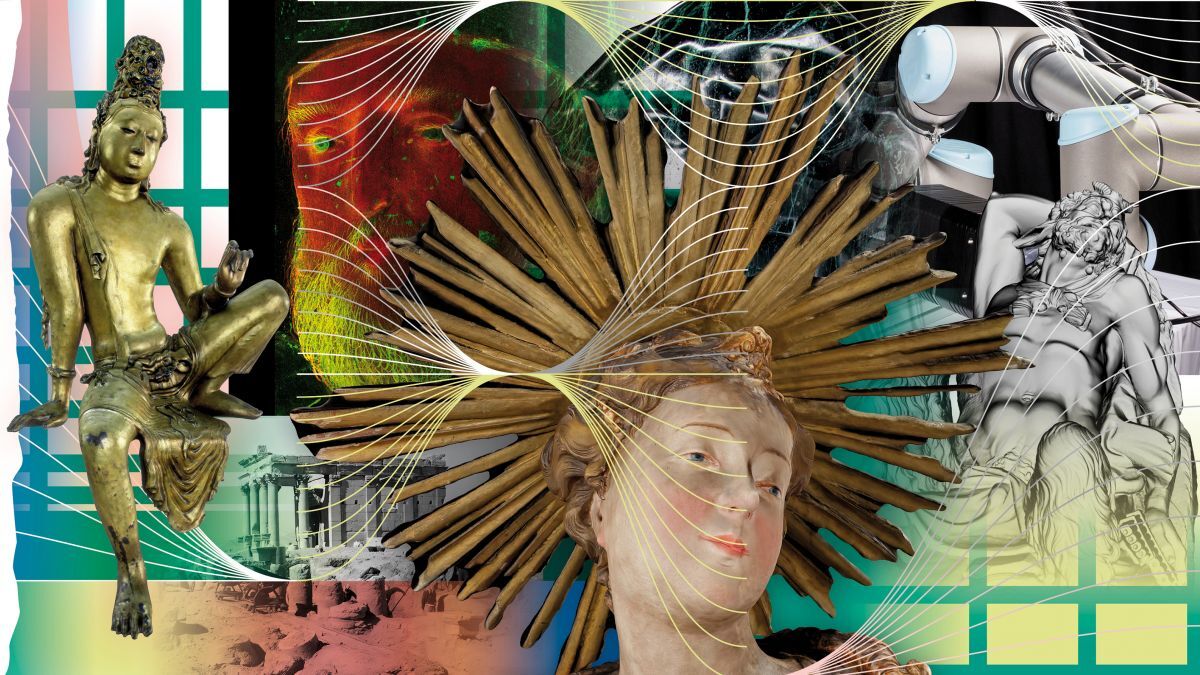
Outputs :
After 4 years of research we have been able to provide the Syrian community with several 3D models and a diachronic visualization tool. Almost 5000 thousands documents have been made accessible. The project’s dataset is accessible through online databases, such as the online open source webviewer Potree. Safe storage and backup is ensured by UNIL.
The project has been presented worldwide in English, German, French, Italian and Arabic. The 4th edition of our pedagogical tool in Arabic (with English translation) has been presented online and is available in PDF format.
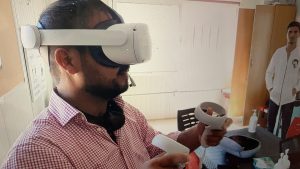
Memory :
The Project, whose aim is to preserve Cultural Heritage and Cultural Memory, ultimately implies sharing the knowledge with the Syrian people. Furthermore, we wanted to include Syrian experts and civil society in the project design. This is the reason why we created an Arabic booklet about the multicultural history of Palmyra.
The booklet also functions as an educational tool, which includes a detailed explanation of an embroidery activity. While reflecting on the issue of preserving cultural memory, we came to the conclusion that intangible with tangible heritage should be combined. We decided to use ornamental designs from the destroyed Baalshamîn temple to produce embroidery patterns. As A. Schmidt Colinet has shown in a study in 2019 (« Bauornamentik und Textilmuster in Palmyra », in : B. Wagner-Hasel et M.-L. B. Nosch, Gaben, Waren und Tribute. Stoffkeislaufe und antike Textilökonomie, Stuttgart: Franz Steiner Verlag, 2019, p. 477–485), the iconographic patterns of the ancient city of Palmyra were sometimes the same for architectural features and textile products.
We therefore produced models and canvases that are used for embroidery in refugee camps or schools. Actively using such patterns for embroidery was the inspiration for a range of activities that take into account tangible and intangible heritage. They demonstrate the value of the Baalshamîn temple Heritage as part of Syria’s collective past. The local embroidery tradition allows culture to be performed through applied arts.
The Collart-Palmyre Project’s Social and Pedagogical Embroidery Activity
In the summer of 2019, members of the Collart-Palmyre Project (CPP) met with Mrs. Sarah Chardonnens – the then Social cohesion and Peacebuilding advisor for the United Nations Development Programme (UNDP) – to talk about an embroidery activity developed within the framework of the Collart-Palmyre Project.
This activity carried both social and pedagogical value and was meant for members of the Syrian community. Mrs. Chardonnens strongly supported this plan. Six months later, several members of the CPP had worked on the design of the embroidery patterns, gathered the necessary material for the implementation of the activity, and sent it to Mrs. Chardonnens, who brought the equipment with her to Syria. This included an original Arabic booklet on the history of Palmyra, its multicultural aspect and the importance of the textiles in the history of the city, as well as embroidery tools.
In 2020, the Collart-Palmyre Project (UNIL) and UNDP-Syria planned and implemented social and pedagogical embroidery activities in various cities in Syria.

Textiles dating to the first centuries AD were found in Palmyra – some in the necropolis of Palmyra and others in the Elahbel tower (103 CE). These textiles were commonly used in the daily life of the inhabitants of Palmyra; they accompanied them also in the afterlife. Linen fabrics came from the East and were decorated with dyed wool coming from the Mediterranean coast. Some of the wool fabrics were combined with silk, which was later identified as coming all the way from China, dating from the Han period (2nd century CE).
The embroidery activity was not a random choice. In fact, it was inspired by an antique tradition that Andreas Schmidt-Colinet explained in his 2019 article on Palmyrene textiles . He showed the popularity of the Palmyra embroidery patterns during antiquity, underlining the evolution of the patterns embroidered on the clothes. In particular, he suggests how the patterns were designed for the clothes carried by the living; then, out of fashion and popularity, they were copied on the sculpted clothes of the statues. These patterns became so popular that they were drawn and etched on the walls of the temples as decorative motifs. The CPP’s activity wished to echo this antique tradition. However, the approach was the opposite: the design patterns observed on a merlon excavated on the site of the Baalshamin temple by Paul Collart was to be applied to textiles. Working on such patterns directly linked the embroidery activity with the Syrian cultural heritage, which was key for the activity’s success and overall relevance.
In the summer of 2020, a year after the CPP and UNDP-Syria staff first met, the embroidery activity was implemented in Syria. Thanks to the excellent work of our partners, the activity was rolled out in five Syrian cities: Aleppo, Hama, Damascus and its suburb, Sweida, and Quneitra. UNDP-Syria organised thematic days on “Women Empowerment” and linked the embroidery activity to the history of Palmyra’s famous queen Zenobia. The overall object was to increase awareness on the importance of the material and immaterial cultural heritage of Syria. Since then, the activity has been offered in 2021 in Azraq refugee camp, Jordan, and in Idlib (Syria).
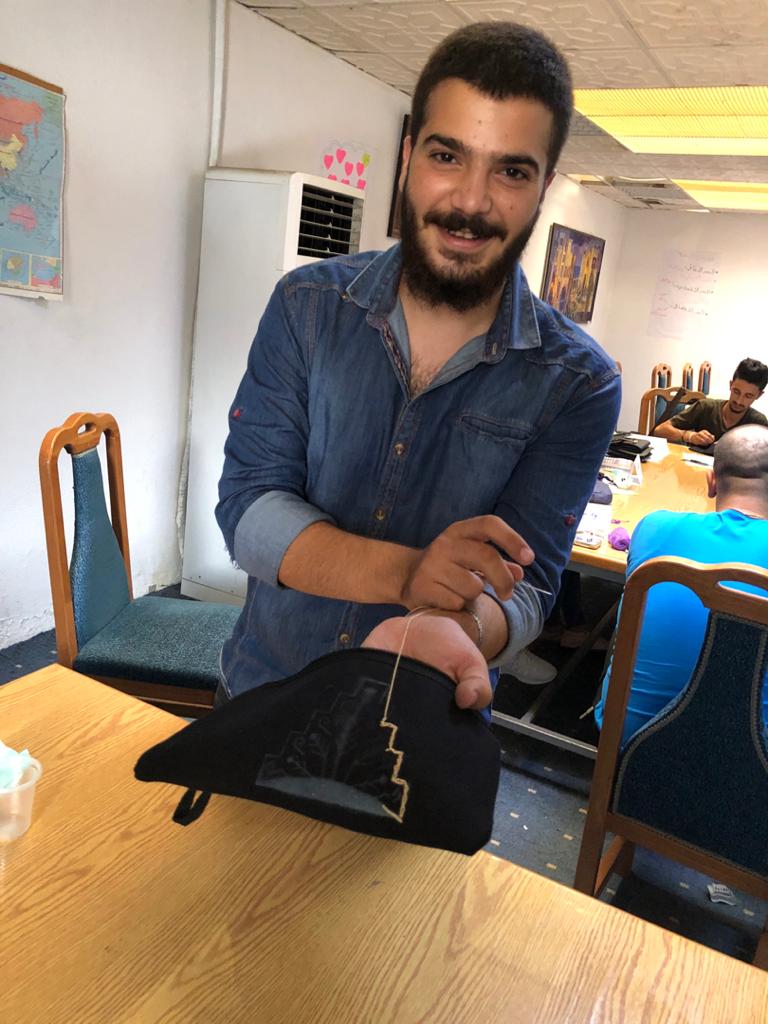
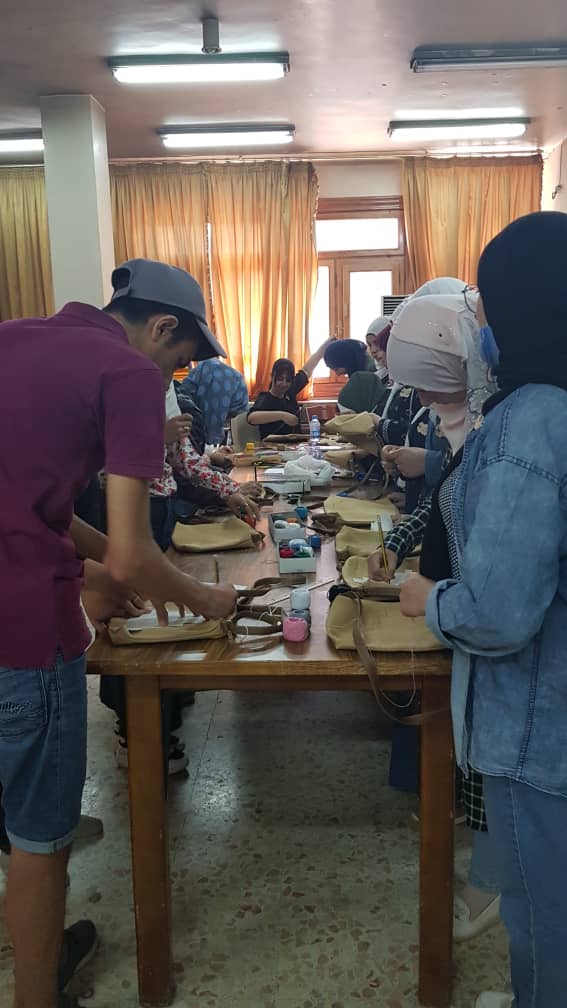
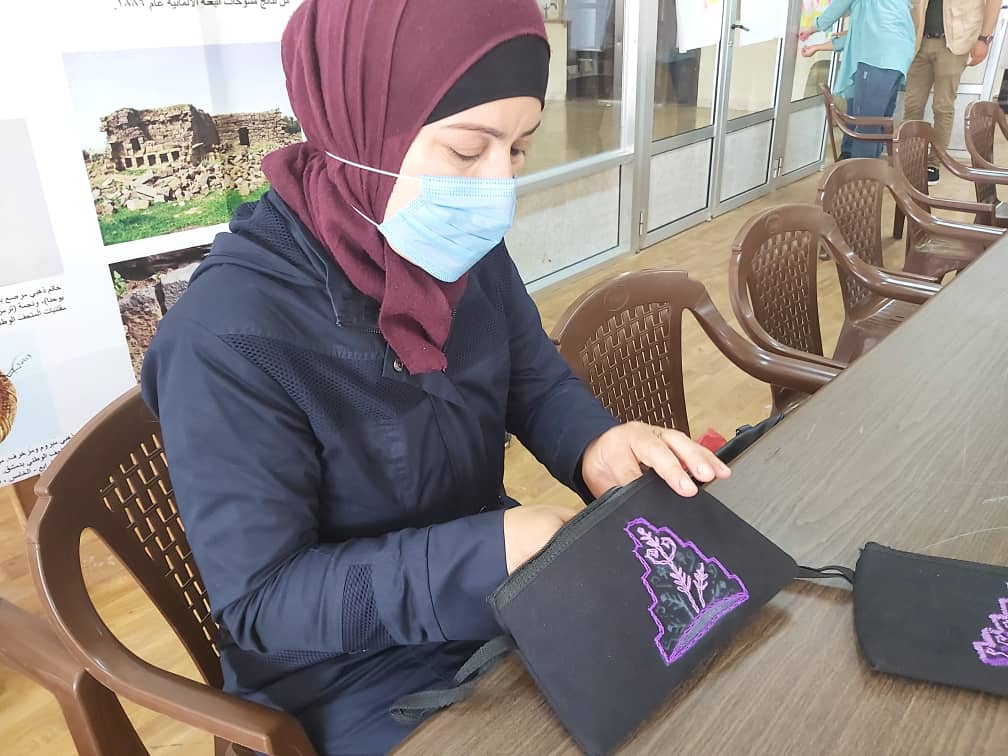
Booklet for the dissemination of Palmyra’s collective heritage
Booklet for the dissemination of Palmyra’s collective heritage
In 2021 the Collart-Palmyre project has worked with InZone (University of Geneva), IULM (Milan) and a group of Syrian refugees living in Azraq camp, Jordan, to create an educational booklet to facilitate the dissemination of Palmyra’s collective heritage.
The booklet, which is available in English and Arabic on the project’s website, retraces the rich cultural history of Palmyra and its monuments until the recent destruction of the temple, which prompted its publication. A section is dedicated to how contemporary artists perceive Palmyra’s heritage.
The booklet is enhanced by numerous photographs from the Collart Archive as well as photographs taken by researchers. Hard copies of the booklet will soon be shared with project partners around the globe (ICCROM, UNESCO, Palmyra Voices, IULM…).
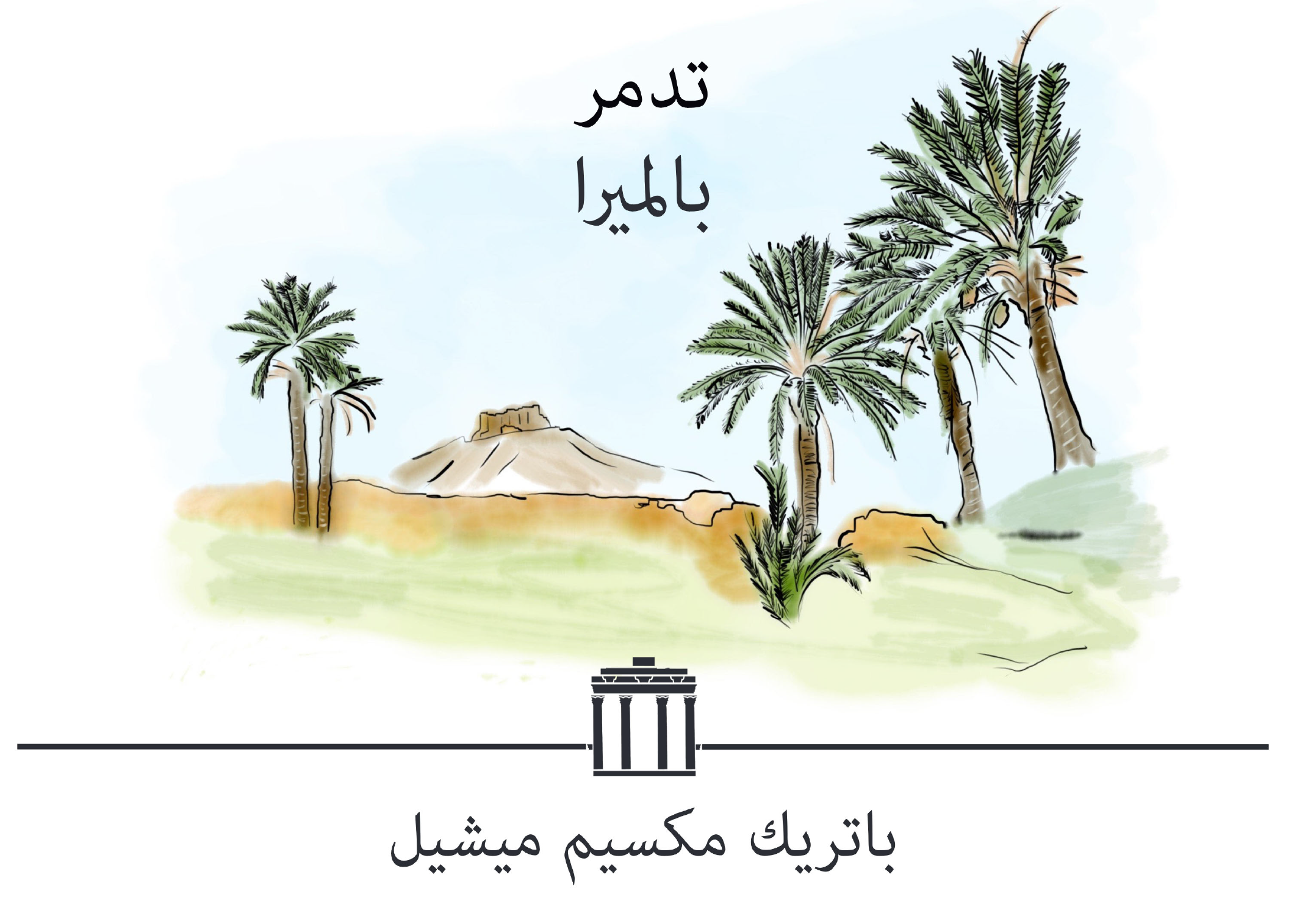
Approach and methodology
The digitization process of the archive consisted of scanning and editing pictures with photoshop, as needed. We followed best practices and standards whenever possible and we adapted a flexible approach.
All documents have been indexed in a database accessible online on Tiresias.unil.ch – the database of the Institute of Archeology and Classical Studies of Lausanne University.
The specific database for artefacts was created in English in collaboration with ICOM-Austria. It follows the “Object-ID” international Standard. It has been made accessible to Europol thanks to the collaboration with ICOM.
Virtual archaeology respects international standards. In order to follow the London Charter and the Sevilla Principles for Virtual Archaeology, we published our research on the online database of the Technische Universität Darmstadt, the Digital Design Unit database called The Reconstruction Argumentation Method. The latter database ensures transparency and is necessary to understand the 3D modelling created within the framework of the project.
By using open source online viewers like Potree we have allowed third parties to reuse the functionalities we have developed. We have given access to functionalities developed within the framework of the project to the benefit of the wider community. Potree is a free open-source WebGL based point cloud renderer for large point clouds. Many functionalities already exist; however, one can also create new ones. By building an open source tools, viewers can easily visualise and link complex objects and collections.
People can learn from our work and use the same tools. By using the timeline function, the 3D model can be viewed through the course of time. This function offer a diachronic visualization of a monument. It has been presented in a webinar and is openly accessible.
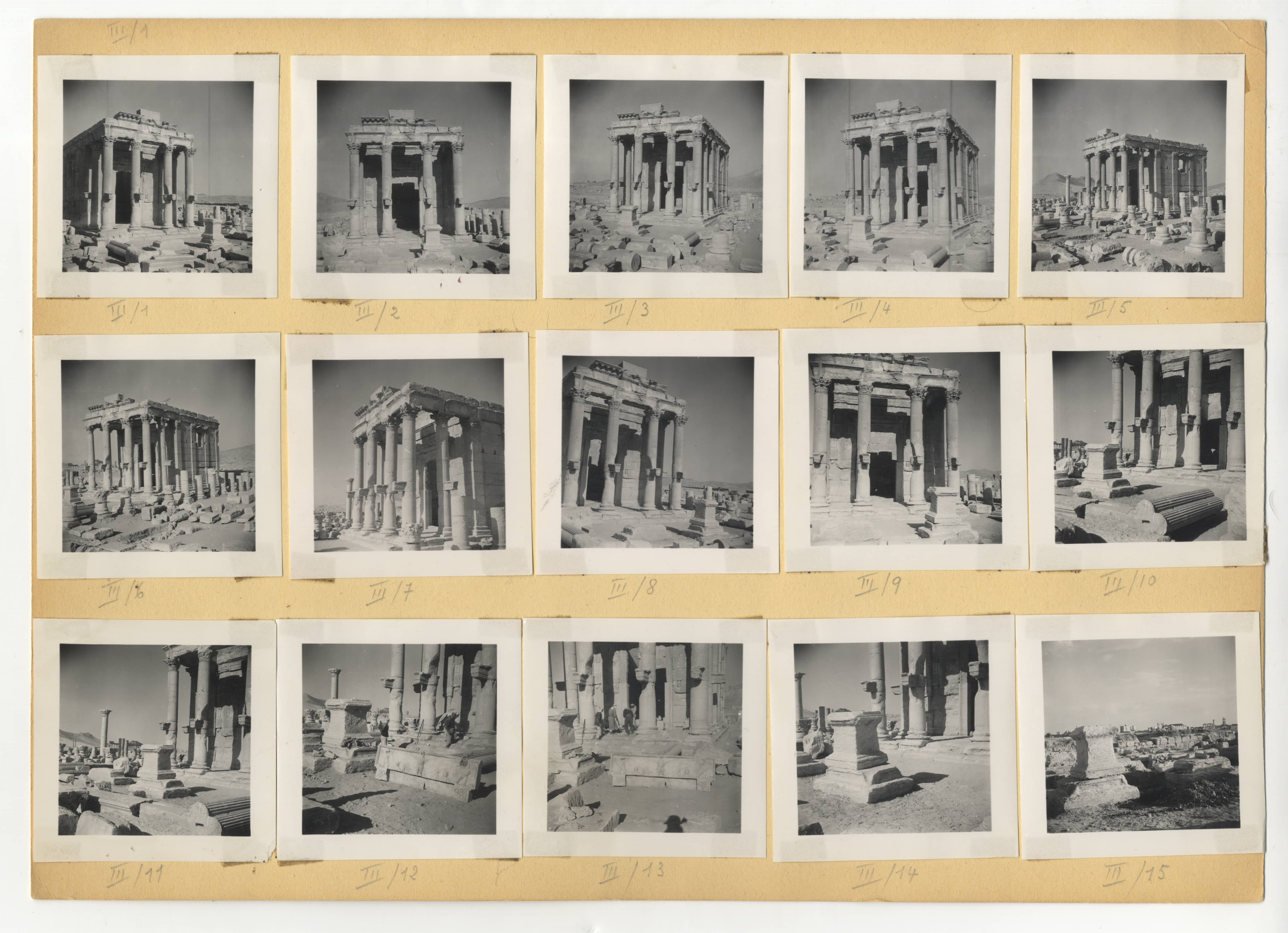
Results
We have been able to gauge the success of the social and pedagogical activities thanks to the feedback received from our partners. A survey was conducted in collaboration with one NGO (The Day After); the average result was 91%, which indicates the significant number of trainees and the benefit in terms of practical and theoretical experience. Individual interviews were conducted with the trainees to investigate the impact of the workshop and explore the benefit for each participant. We have taken note of the recommendations trainees made to improve the workshop. We also hired a sociologist in Switzerland to conduct qualitative interviews to evaluate the meaning of the virtual reconstruction for Syrian Refugees in Switzerland. Results of this study are on display at the Deep Fakes. Art and its Double exhibition at EPFL Pavilions.
Feedback included photos and videos. Thank you cards in Arabic and in English, written by the participants who attended the activities, were also recorded.
The database and the 3D models hosted on openly accessible platforms ensure that this kind of virtual memory can be accessed and preserved. Furthermore, the workshops conducted in Syria and Jordan allowed local people to be involved in the project, giving them a way to share its outcomes.
Dissemination was conducted through numerous exhibitions and events in Switzerland, in Europe, the Middle East and in the united States. Working in Europe and the USA was essential to share the project outcomes widely, to raise awareness and avoid duplicates. Sharing research, experience and results proved to be strategic for the interoperability and collaboration aspects. International cooperation (French Ministry of Culture, ALIPH, Swiss Institute in Rome, IULM: Università di Communicazione e Lingue Milano, DAI Germany, MIT Future Heritage Lab, UC San Diego, Digital Library of the Middle East, Aga Khan Trust for Culture, ICOM) was essential for our team. We have thus been able to integrate changes or observations suggested by the wider community working in the field of Palmyra and Heritage preservation.
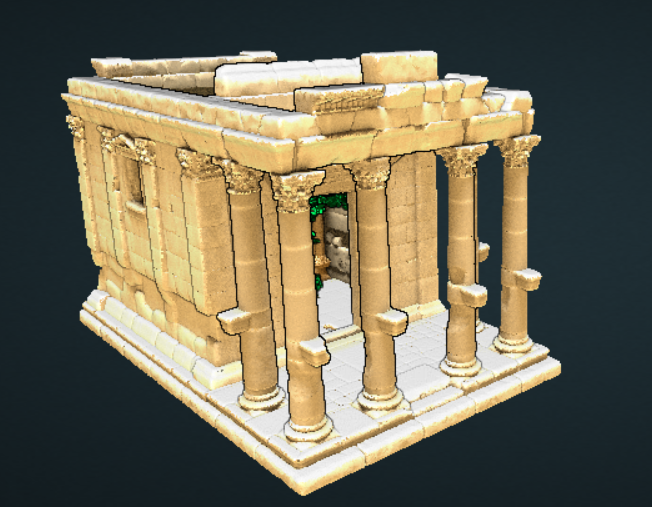
Innovative aspects
The most innovative aspect of the project is its social impact component. Thanks to the activities developed for and with various NGOs, as well as the sociological study, we have been able to integrate the input of Syrian archaeologists and Palmyra residents. Regarding the pedagogical activities, combining tangible and intangible heritage was truly innovative. The embroidery activity shows that knowledge can be transmitted through cultural heritage.
Concerning the 3D model, the timeline function offering a diachronic visualization experience of the monument is pioneering. It allows the Baalshamîn temple to be integrated in the changing identity of the site of Palmyra from the late Hellenistic period (2nd century BC) to the Islamic period around 9th century AD. This diachronic visualisation underlines the multicultural aspects of this ancient city.
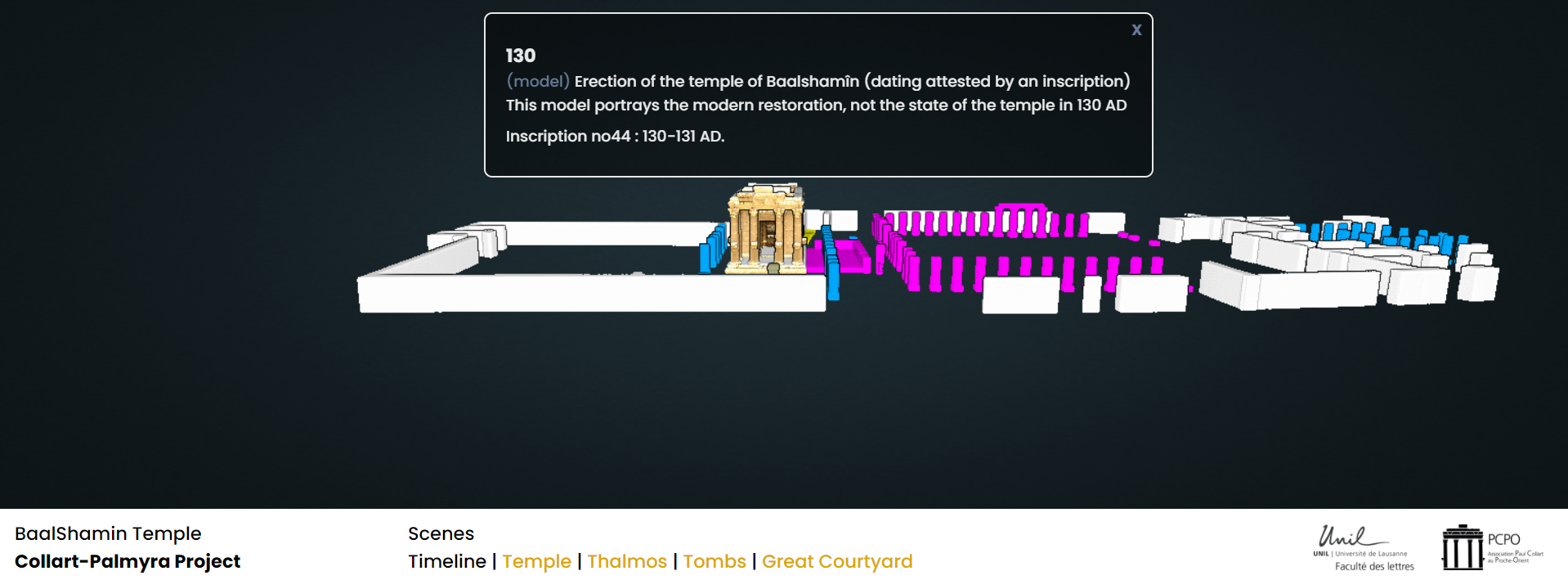
Sustainability
Open source policy ensures that all data are openly accessible and can be downloaded by scientists around the world through the Potree online viewer. A backup system is provided by the University of Lausanne. As the scientific manager of the project is the co-founder of the NUCLEUS Center of the Faculty of Arts, particular attention has been paid to the issue of digital sobriety.
